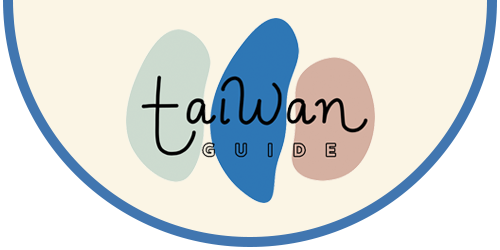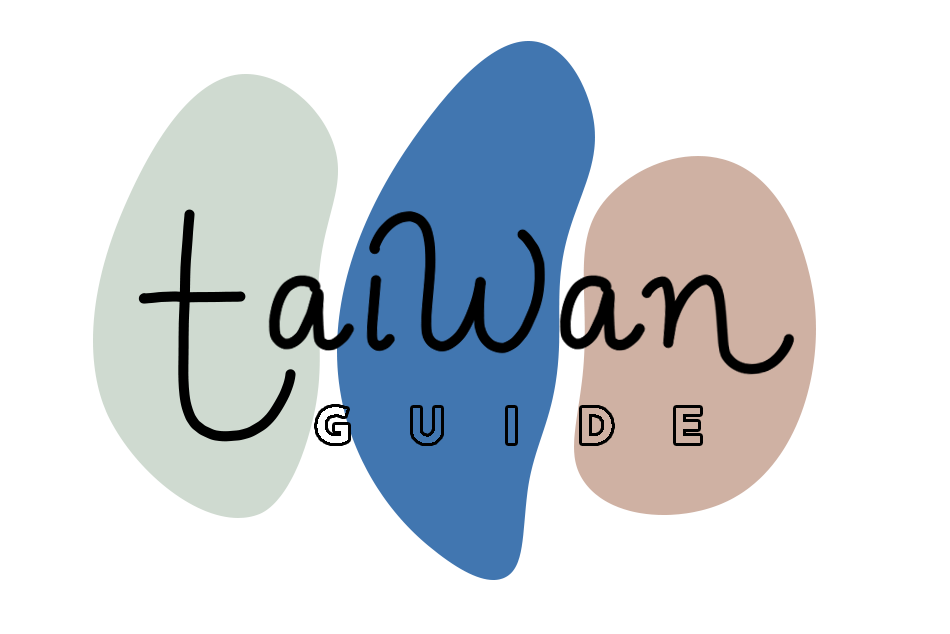The true foundation of Taiwanese society boils down to the welcome jingle and woosh of AC as you step through the automatic doors of a convenience store.
Now, you might think you know convenience stores, but you don’t truly understand the meaning of convenience until you’ve experienced a Taiwanese convenience store. If you’ve been to Japan or another Asian metropolis, you might have some idea. But Taiwan has taken it to the next level.
REPEAT AFTER ME
7-Elevens in Taiwan are not the same as 7-Elevens in America
Besides the fact that they share the same name, and that 7-Elevens in Taiwan do have slurpees, they are completely different stores that with a completely different inventory (not just localized versions of the same stuff). Technically, 7-Elevens in Taiwan are owned and managed by Uni-President Enterprises Corporation. But most importantly, they aren’t sad gas station marts. They are oasis from heat and hunger and dehydration with impressive coverage around the island.
Ok, now that we’ve got that out of the way, let’s talk culture.
There are several franchises of convenience stores in Taiwan. The biggest one is 7-Eleven (given the friendly nickname “Seven” by locals), followed by FamilyMart (a Japanese chain), Hi-Mart (a Taiwanese chain) and OK Mart (branch off from Circle K). Together they make up a network with incredible coverage across the island.
Taiwan has the highest density per capita of convenience stores in the world. There are over 10,000 stores, about one for every 2,300 people. If you take a picture on a random street in Taipei, chances are, you’ll spot at least a couple stores in the background. Sometimes there are two 7-Elevens facing each other, and a FamilyMart around the corner. Even in smaller towns like Taitung, you can count on there being a 7-Eleven at the corner of every other intersection.
TO BE HONEST
Taiwanese convenience stores are more reliable than your most dependable friend.
First of all, you’re never more than walking distance from the nearest one (ok fine, if you’re on a tea farm in the mountains, it might be a long walk…but still!). They are on the boulevards and in the alleys, as well as in MRT stations, airports, hospitals, corporate buildings, apartment complexes and schools. Also, they are open 24/7, rain or shine, even during typhoons (the 7-Eleven dog? mascot ain’t playing when it says “always open, 7-Eleven”). It’s a one stop shop for anything you might need at 3am, and plenty of things you might not need too. It’s the perfect place to hide out from the afternoon downpour. Even if the downpour lasts a few hours (it likely will).
The convenience store market may seem saturated, but Taiwanese society is so fully reliant on its network of convenience stores, I’m fairly sure that society would collapse if this system disappeared.
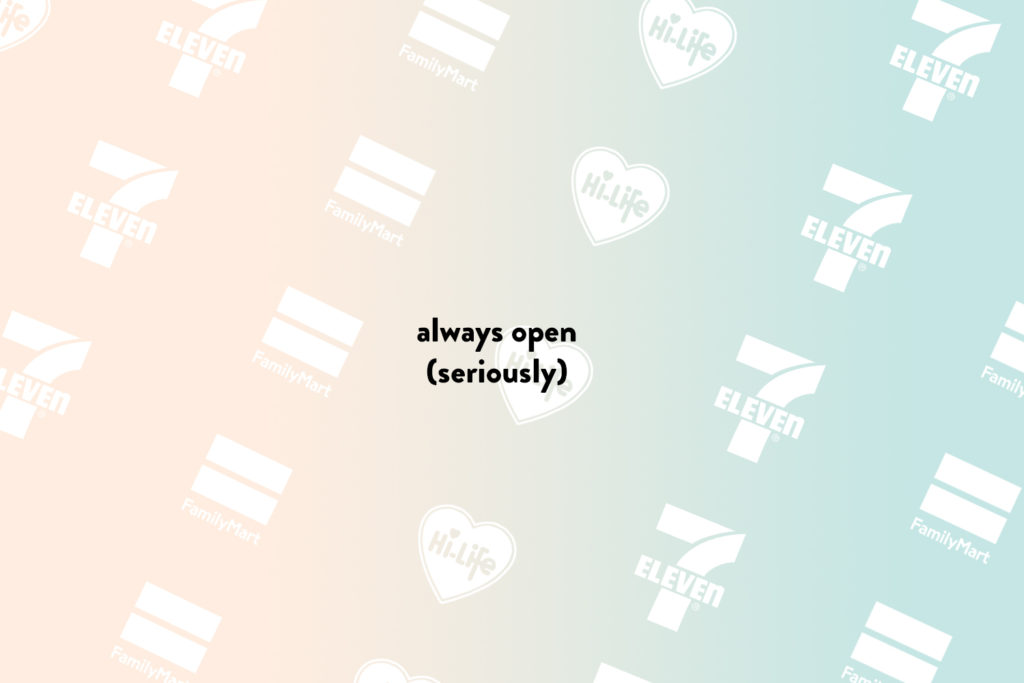
a little orientation
The first thing you’ll notice when stepping into a convenience store, besides the beloved jingles (seriously, someone even remixed one!), is the herbal smell of tea eggs. They’re always stewing away, alongside Japanese oden, steamed buns, baked sweet potatoes, hot dogs…
And this is only the hot food. But before we get into what else you can buy, let’s sample the services a typical Taiwanese convenience store offers. You can, at your convenience:
- Pick up online orders (a lot of people prefer to pay in cash rather than online)
- Pick up packages (they had this down WAYY before Amazon lockers, you can get anything sent to your closest convenience store and they’ll sign for you)
- Buy concert tickets (why go online when there’s ticket booths every block?)
- Pay your phone bills (save on postage, just go down the street)
- Buy prepaid phone cards, and refill them (this is actually v useful for visitors…not just for locals in need of burner phones…)
- Check your blood pressure (idk I saw one before, didn’t question it)
- Send things locally (yes, it’s like an actual network of convenience stores where you can send something from a 7-Eleven in Taipei to one in Kaohsiung + way more open hours than any post office!)
- Make copies and print things (it’s like a built-in FedEx…well, they actually do partner with FedEx too)
- Heat things (they have a microwave, and when you buy refrigerated or frozen food there, they can heat it up for you to dine in lol)
- Make cup noodles (you can buy and enjoy right away with hot water readily available)
- Do your business (many of them now have a restroom – they usually display a sign outside so you know)
- Dine in (many have seating areas, and since you can already heat up what you bought, might as well settle in – unlike most cafés, they don’t have a minimum order or maximum seat time)
- Drink (sounds kinda sad, but hey you can pregame at your convenience)
- Refill EasyCards (& pay with them too)
- Pick up (& return) library books
- Pay parking fines (I bet it’s a more pleasant experience than the LADOT website…)
- Buy train and HSR tickets (another actual useful thing for visitors)
- Cool off (you laugh now, but wait till you meet tropical humidity…)
- Use free wifi (between convenience stores and MRT stations, you can basically have free wifi anywhere in Taipei)
- Get fresh made coffee and teas that aren’t half bad (yes, they actually market themselves as “cafés” too, and recently started selling boba milk tea as well)
- Use an ATM (in case you run out of cash in the middle of a night market, just dash into the nearest convenience store!)
- Collect swag (Taiwan is obsessed with stamp cards, collecting stickers, earning points…whatever it takes to redeem a reward. And convenience stores have totally mastered the art of capitalizing on this. They strike up valuable partnerships with brands like Sanrio to run promos for exclusive collectables. If you think people can’t spend 1000NT at a convenience store, think again)
Mind you, there’s often only one or two people running shop at a time. So these clerk-cashier-barista-concierge-custodian-inventory managers are the real MVPs in Taiwan.
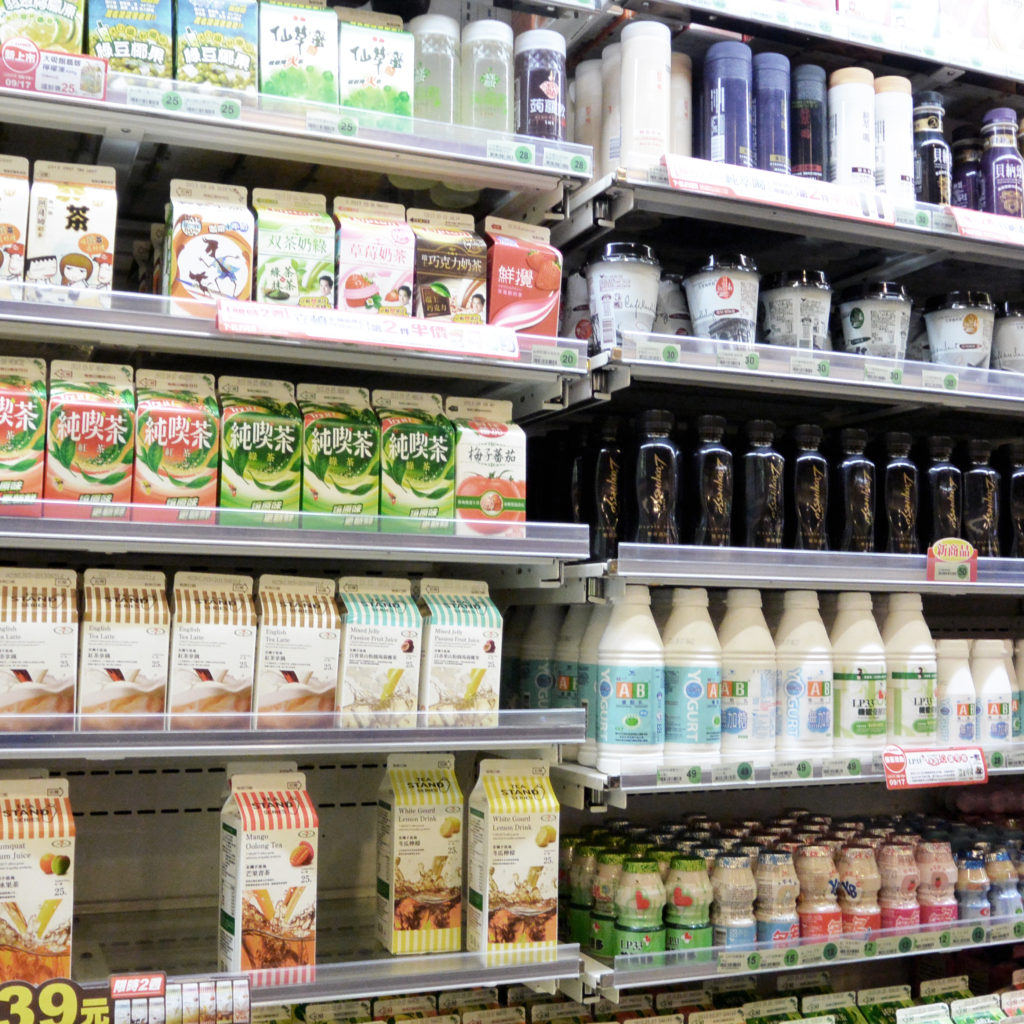
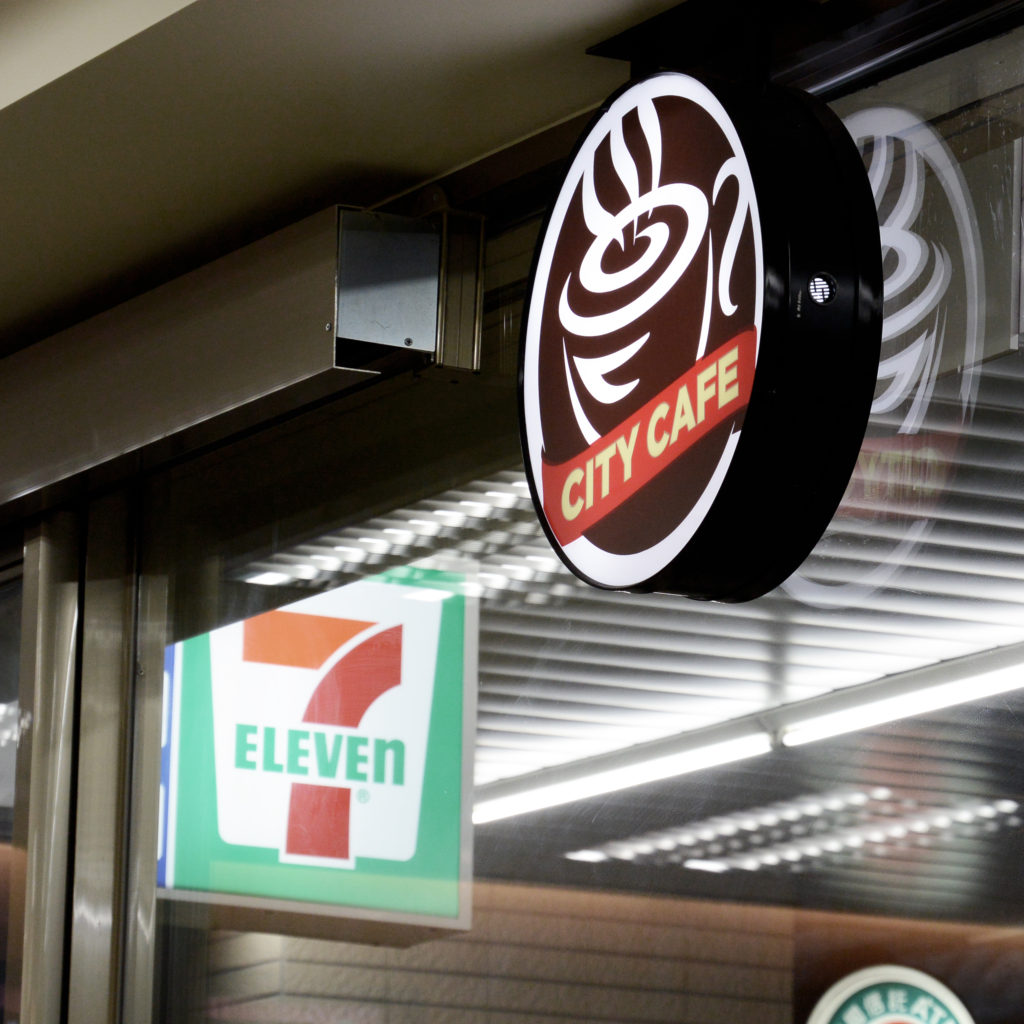
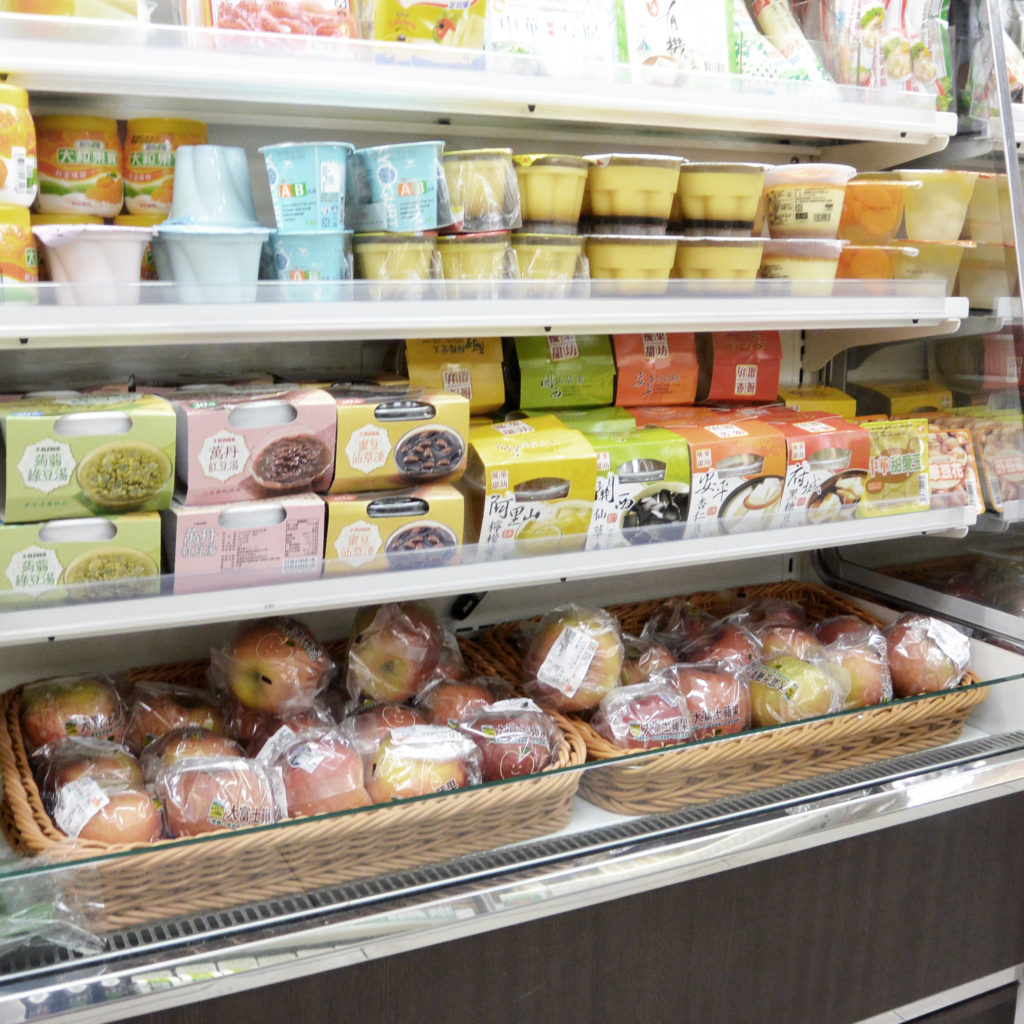
moving on to the goods
Whether you’re looking for a bag of chips or disposable underwear, a bag of rice or some MUJI stationary, you’d be surprised how much they can pack into a tiny (or sometimes not so tiny) store. Both 7-Eleven and FamilyMart have their own branded products alongside other local and international CPG brands (a la Kirkland re: Costco), and true locals always have an opinion on which brand is best. Some convenience store products garner a cult following.
DRINKS
Your usual spread of Asian iced teas, aka more varieties than you would ever care to imagine. Plus juices, yogurt drinks, flavored milks, iced coffees and soda (a section that is dwarfed by the tea). Cartons and small bottles are in the open refrigerator areas, while typical bottles and cans are in the doored refrigerators (no idea why). And then of course there’s always the beer section, which has the classic “Taiwan Beer” as well as fruity variations that taste like slightly alcoholic juice.
If you like things sweet, go for lemon black tea or honey jasmine. If you are a fan of Starbucks bottled frapuccinos, go for the navy blue cylindrical 純粹喝 iced latte. It literally tastes like coffee ice cream. If you want something very local, grab some green tea yakult (it’s good for digestion) or papaya milk. If you want to try a fruity beer, go for pineapple. Or mango (but actually get pineapple). If you’re looking for Gatorade, try the local brand Supau. Everything should be in the 15-30NT range, and they almost always have promos for buy one get one half off or something. Look for the signs by the prices.
SNACKS
Chips, crackers, cookies, candy, you name it, they have it. Sure, you might spot some familiar names like Doritos or Oreos, but the flavors certainly will be foreign. Be adventurous. Pick up some seaweed flavored Lays. Or try some boba milk tea flavored snacking ramen (literally just crunchy noodles packaged like chips). Or just head to the candy section and buy every flavor of Hi-Chew you can find, as well as other coveted Asian candies that cost a fortune in the US. I’ll just go ahead and warn you that there is a Japanese/Korean chocolate brand called Ghana which is totally not meant to be insensitive but definitely comes across as questionable. To freshen your breath, grab a pack of Airwaves gum. It’s unnecessarily minty, no matter what flavor you choose.
instant noodles
You really can’t go wrong. This is life changing compared to the typical Nissin or Maruchan you buy in 48 packs at Costco. Hint: if there aren’t several flavor/soup/oils/condiments packets you need to open before adding in the water, it’s probably not gonna be life changing. Usually, Taiwanese brands have two packets, one with powder flavor and another with a sauce or oil (sesame oil, chili oil, soy sauce, shallots, etc), but some really push it in terms of what they manage to stuff in there.
There’s brands that specialize in “dry” noodles (where you drain the water before mixing in the add ins, and usually comes with a separate soup packet and second bowl). Wei Lih is the classic, but now there’s a bunch of different brands that do this. There’s a brand that boasts double the noodles (literally, you get two disks of noodles instead of one). The trends are ever-changing (the latest hype being TTL Hua Tiao Chicken Noodles, which comes with real chicken and real alcohol – betcha wish you had this in college). But if you want a reliable favorite, go for the minced pork flavor of One More Cup.
from the fridge
There’s everything from salads to fruit cups to cold sesame noodles (liang mian) to beef noodle soup to congee to curry rice (& other packaged meals that the clerk will kindly heat for you). But really all you need are the pre-packaged onigiri (the triangle rice balls). There’s at least a dozen flavors so you can practically live on this stuff.
Also, pudding. The classic 統一 pudding that is light yellow with dark brown caramel at the bottom. Kinda like flan, but with a distinct texture and flavor. It’s inspired dozens of spin-off products and DIY recipes. No other brand comes close to matching the flavor and no one knows why. It got to the point where one time it was recalled for a week and as soon as it hit shelves again, it immediately sold out.
frozen treats
When it’s a million degrees outside, the little ice cream freezer is your best friend. The pudding popsicle tastes like the real stuff. Also, the caramel wafer-enrobed ice cream is 👌. Of all the different sections, this one is probably the fastest changing. It seems like Taiwanese people welcome and kick out ice cream and popsicle products at an alarming pace. The trends are forever shifting, so don’t get too attached to any given product. Some things have withstood the test of time (maybe from nostalgia?) like the strawberry ice cream bar and the yellow and red 小美 ice cream containers (which honestly barely tastes like ice cream, it’s more of an old school “frozen dessert” back before ice cream became a thing here). Ironically, the one thing that you’ll always find is a mini fridge full of single serving Haagen Dazs ice creams, which for some reason Taiwanese people are obsessed with, and willing to shell out much more $$ than it’s worth.
& everything else
On top of all the edible stuff, there’s also anything else you could possibly need. Magazines and newspapers, household items, stationary, emergency clothes (think plain t-shirts, socks, etc), umbrellas (lifesavers for sure, and for 100NT a pop, they’re sturdy enough for Taiwan rain), toiletries, bags of rice, face masks, cleaning supplies, kitchen utensils, bug spray, medication, electronic accessories, etc etc etc.
some pro-tips
- Head to the airport an hour early and enjoy your last meal in the airport food court. Don’t worry, the prices are not surged like they are in American airports. While you’re there, stock up at the 7-Eleven for the plane ride, no need to do a haul before the airport. Just remember no liquids! Anything else can go with you on the plane (but fruit and anything with meat have to be eaten on the plane – can’t bring that back with you!)
- As soon as you hear about a typhoon, if you are staying at an apartment (anything that isn’t a hotel, etc) go to any convenience store and stock up on a couple big 2L bottles of water just in case. And some ramen. And beer. Those tend to be the things that run out first as people stockpile for their days off.
So what’s the cost of convenience? Just a few minutes of your time and a tap of your EasyCard actually. Things are fairly priced. Sure, it might be cheaper to grab fruit from a traditional market or to get big packs of pudding from a supermarket. But the difference is marginal, so it’s worth it for the convenience. And once you get home, you’ll wish home embraced Taiwan’s culture of convenience too.
Last updated: January 2021
